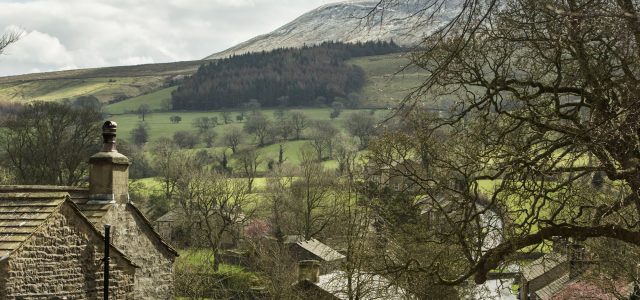
BOWLAND VILLAGES:
DOWNHAM
Author and research chemist Andrew Stachulski visits Downham. Photography: Helen Shaw
Downham is probably one of the best known of all the villages in the Ribble Valley. To many old-timers, it seems incongruous to link Downham with Bowland, as it lies very much in the province of Pendle Hill, whose inescapable presence dominates the village. Yet the definition of the Area of Outstanding Natural Beauty includes both the Forest of Bowland and a smaller area surrounding Pendle, which grants Downham its inclusion.
Downham, like Slaidburn, remains a true estate village to this day, harking back to the medieval manor of the Asshetons – there has been a lineal descent through the family since 1680. It is difficult not to be wholly charmed by Downham, what a throwback it is! No overhead wires, no satellite dishes, no signs spoil the view here. Just stroll down the main street of the village and enjoy soaking up the atmosphere. When you emerge from the parish church of St. Leonard’s into the churchyard, Pendle’s dominance is breathtaking – it seems to fill half the sky. The Assheton Arms, by the road junction, has been extensively refurbished of late and offers fine food and accommodation.
The beauty and character of Downham’s environs have been recognised by filmmakers – not long ago we celebrated the 50th anniversary of ‘Whistle Down the Wind’ (1961), a delightful story of childhood innocence and growing up.
Much of the action was shot at Worsaw End Farm, near Downham. More recently, and more obtrusively, the TV series ‘Born and Bred’ was filmed in the village, with a number of sets temporarily erected and used over a period of around four years. Keep a lookout for open days at Downham Hall and its lovely grounds. The hall is home of Ralph, Lord Clitheroe and is on the site of the medieval hall occupied by Sir Ralph Assheton. At one time, I remember, you could spot redstarts in the grounds of the hall and in the surrounding lanes. I wonder if these delightful summer visitors still frequent the area?
Walkers have long used Downham as a base for a number of excellent rambles, short or long, low level or high, including the summit of Pendle. Be warned however, the ascent of Pendle (557m, or 1,829 ft) is dauntingly steep from this side. If you dare take it on, you can walk up the Barley road and turn right into the fields shortly after the road turns left by Hookcliffe Plantation. Here a notice confirms the route, and gird up your loins! The steepness is broken further up by zigzags as you approach the summit, but you will be justified in stopping to take in the glorious panoramic view, as well as to catch your breath. From the summit, views are superb all round, and many will appreciate the soothing view down the Ribble estuary towards the sea in the west. From north west to north east is perhaps the finest arc of all, an inspiring sweep of fells from Bowland to deep into the Dales, the Three Peaks prominent, and on days of exceptional clarity you can spot both the Lakeland fells and the Howgills. Indeed Pendle is so dominant in the local district that there is no surprise its height was considerably exaggerated by ancient writers.
There are a number of other delightful villages in the vicinity, readily visited from Downham as a base and this makes a splendid circular tour of moderate length. For a start, leave Downham by the Barley road, climbing to the crossroads at Annel Cross, said to be the site of the last public execution in Lancashire. Even from this relatively modest height of about 1,000 ft., there are lovely panoramic views. From here you should go on to Barley, then nearby Roughlee, where Alice Nutter, associated with the Lancashire witches story, once lived. The difference in the appearance of Pendle from this side, the Forest of Pendle, is most apparent as it is a rougher, bleaker aspect compared to the lusher, green appearance of the Downham-Worston face where much limestone is exposed.
Continuing the Lancashire witches theme, Newchurch is only a short distance from either Barley or Roughlee. The witches were said to have foregathered here, though the location is uncertain, possibly at nearby Sabden Fold. A sequence of lanes takes you on to Sabden, an increasingly popular residential spot, then a steep climb to the Nick of Pendle, a prominent cleft in the ridge leading south west from Pendle’s summit. On the far side, you should take in Pendleton, a charming small village with its clear stream dividing the main street and the recommended Swan with Two Necks for refreshment. From here, you quickly regain the A59 briefly, then pass through Chatburn to return to your starting point.
Andrew Stachulski and Helen Shaw are the authors of ‘The Forest of Bowland’

